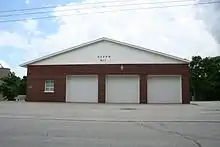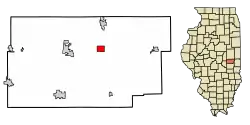Camargo, Illinois
Camargo is a village in Douglas County, Illinois, United States. The population was 445 at the 2010 census. Camargo is at the intersection of Illinois Route 130 and U.S. Route 36. Camargo is the oldest township in Douglas County. In 2006, the first annual Camargo Woolly Worm Festival was launched during the first weekend in October, attracting several local celebrities. This is to be an annual event.

Camargo | |
|---|---|
 Camargo, Illinois Post Office, 2007 | |
 Location of Camargo in Douglas County, Illinois. | |
.svg.png.webp) Location of Illinois in the United States | |
| Coordinates: 39°47′56″N 88°9′54″W | |
| Country | |
| State | |
| County | Douglas |
| Township | Camargo |
| Area | |
| • Total | 1.27 sq mi (3.30 km2) |
| • Land | 1.26 sq mi (3.26 km2) |
| • Water | 0.01 sq mi (0.03 km2) |
| Elevation | 653 ft (199 m) |
| Population (2010) | |
| • Total | 445 |
| • Estimate (2019)[2] | 447 |
| • Density | 355.04/sq mi (137.07/km2) |
| Time zone | UTC-6 (CST) |
| • Summer (DST) | UTC-5 (CDT) |
| ZIP code | 61919 |
| Area code(s) | 217 |
| FIPS code | 17-10591 |
| Website | camargoinfo |
Geography
Camargo is located at 39°47′56″N 88°9′54″W (39.798775, -88.164942).[3]
According to the 2010 census, Camargo has a total area of 1.273 square miles (3.30 km2), of which 1.26 square miles (3.26 km2) (or 98.98%) is land and 0.013 square miles (0.03 km2) (or 1.02%) is water.[4]
| Historical population | |||
|---|---|---|---|
| Census | Pop. | %± | |
| 1880 | 339 | — | |
| 1910 | 323 | — | |
| 1920 | 336 | 4.0% | |
| 1930 | 271 | −19.3% | |
| 1940 | 257 | −5.2% | |
| 1950 | 236 | −8.2% | |
| 1960 | 276 | 16.9% | |
| 1970 | 241 | −12.7% | |
| 1980 | 428 | 77.6% | |
| 1990 | 372 | −13.1% | |
| 2000 | 469 | 26.1% | |
| 2010 | 445 | −5.1% | |
| 2019 (est.) | 447 | [2] | 0.4% |
| U.S. Decennial Census[5] | |||
Demographics
As of the census[6] of 2000, there were 469 people, 187 households, and 134 families residing in the village. The population density was 371.2 people per square mile (143.7/km2). There were 197 housing units at an average density of 155.9 per square mile (60.4/km2). The racial makeup of the village was 99.4% White.

There were 187 households, out of which 31.6% had children under the age of 18 living with them, 61.0% were married couples living together, 7.5% had a female householder with no husband present, and 28.3% were non-families. 24.1% of all households were made up of individuals, and 11.8% had someone living alone who was 65 years of age or older. The average household size was 2.51 and the average family size was 3.01.
In the village, the population was spread out, with 26.0% under the age of 18, 7.2% from 18 to 24, 26.7% from 25 to 44, 25.2% from 45 to 64, and 14.9% who were 65 years of age or older. The median age was 39 years. For every 100 females, there were 103.0 males. For every 100 females age 18 and over, there were 101.7 males.
The median income for a household in the village was $39,844, and the median income for a family was $49,375. Males had a median income of $37,500 versus $21,477 for females. The per capita income for the village was $18,369. About 5.3% of families and 6.9% of the population were below the poverty line, including 9.6% of those under age 18 and 3.3% of those age 65 or over.
References
- "2019 U.S. Gazetteer Files". United States Census Bureau. Retrieved July 14, 2020.
- "Population and Housing Unit Estimates". United States Census Bureau. May 24, 2020. Retrieved May 27, 2020.
- "US Gazetteer files: 2010, 2000, and 1990". United States Census Bureau. 2011-02-12. Retrieved 2011-04-23.
- "G001 - Geographic Identifiers - 2010 Census Summary File 1". United States Census Bureau. Archived from the original on 2020-02-13. Retrieved 2015-08-02.
- "Census of Population and Housing". Census.gov. Retrieved June 4, 2015.
- "U.S. Census website". United States Census Bureau. Retrieved 2008-01-31.